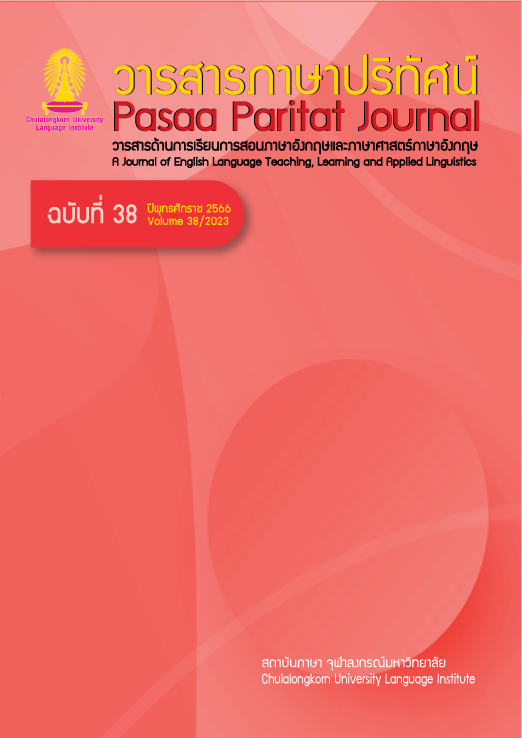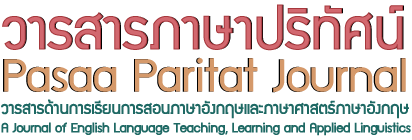ผลของการใช้แฟ้มสะสมผลงานการพูดต่อระดับสามัตถิยะปฏิสัมพันธ์ของนักศึกษาไทยที่เรียนภาษาอังกฤษในฐานะภาษาต่างประเทศ
DOI:
https://doi.org/10.58837/CHULA.PPJ.38.9คำสำคัญ:
สามัตถิยะปฏิสัมพันธ์, แฟ้มสะสมผลงานการพูด, การสอนพูด, การวัดประเมินด้วยแฟ้มสะสมผลงานบทคัดย่อ
สามัตถิยะปฏิสัมพันธ์ได้รับความสนใจในวงวิชาการสอนและวัดประเมินทางภาษามาเป็นเวลานาน เช่นเดียวกับการใช้แฟ้มสะสมผลงานเป็นทางเลือกหนึ่งในการวัดและประเมินในชั้นเรียนเพื่อให้ผู้เรียนได้มีโอกาสในการสังเกตการณ์ในความก้าวหน้าของตนเองและเพิ่มพูนทักษะภาษาในเวลาเดียวกัน การศึกษาวิจัยครั้งนี้มุ่งเน้นพิจารณาผลการใช้แฟ้มสะสมผลงานการพูดต่อระดับความสามารถการพูดและระดับสามัตถิยะปฏิสัมพันธ์ของนักศึกษาระดับปริญญาตรี โดยมีวัตถุประสงค์ดังต่อไปนี้ 1) เพื่อศึกษาผลการใช้แฟ้มสะสมผลงานการพูดต่อระดับสามัตถิยะปฏิสัมพันธ์ของนักศึกษา; และ 2) เพื่อศึกษาผลการตอบรับจากนักศึกษาเมื่อมีการใช้แฟ้มสะสมผลงานการพูดในการจัดการเรียนการสอน เครื่องมือวิจัยที่ใช้ประกอบด้วยบทเรียนที่มีการใช้แฟ้มสะสมผลงานการพูดในฐานะสื่อการสอนและเครื่องมือวัดและประเมินการเรียนรู้ แบบทดสอบการพูดซึ่งทำการทดสอบก่อนและหลังการใช้เครื่องมือในการจัดการเรียนการสอน และแบบสำรวจระดับเจตคติ เพื่อเก็บข้อมูลจากกลุ่มตัวอย่างผู้เข้าร่วมวิจัยจำนวน 42 คนที่รับการจัดสรรตามตารางสอนของผู้วิจัย การวิเคราะห์ข้อมูลวิจัยใช้สถิติเชิงพรรณนาและการวิเคราะห์ paired sample t-test ผลการวิจัยสะท้อนให้เห็นว่าระดับคะแนนสามัตถิยะปฏิสัมพันธ์ของนักศึกษาในการทดสอบก่อนและหลังเรียนมีความแตกต่างอย่างมีนัยยะสำคัญทางสถิติ นอกจากนี้ ยังพบว่าในการสำรวจระดับเจตคติภายหลังจากการจัดการเรียนการสอนโดยมีการใช้แฟ้มสะสมผลงานพูดโดยภาพรวมนักศึกษามีระดับเจตคติสูงขึ้นอย่างมีนัยยะสำคัญทางสถิติ
เอกสารอ้างอิง
Abe, M., & Roever, C. (2019). Interactional competence in L2 text-chat interactions: First-idea proffering in task openings. Journal of Pragmatics, 144, 1–14. https://doi.org/10.1016/j.pragma.2019.03.001
Al-Gahtani, S., & Roever, C. (2012). Proficiency and sequential organization of L2 requests. Applied Linguistics, 33(1): 42–65. https://doi.org/10.1093/applin/amr031
Barraja-Rohan, A.-M. (2011). Using conversation analysis in the second language classroom to teach interactional competence. Language Teaching Research, 15(4): 479–507. https://doi.org/10.1177/1362168811412878
Brown, H. D. (2003). Language assessment: Principles and classroom practices. White Plains, NY: Pearson Education.
Cabrera-Solano, P. (2020). The use of digital portfolios to enhance English as a foreign language speaking skills in higher education. International Journal of Emerging Technologies in Learning, 15(24): 159–175. https://doi.org/10.3991/ijet.v15i24.15103
Çağatay, S., O. (2012). Speaking portfolios as an alternative way of assessment in an EFL context. [Unpublished Master thesis]. Bilkent University, Ankara, Turkey.
Chalhoub-Deville, M. (2003) Second language interaction: Current perspectives and future trends. Language Testing, 20(4): 369–383. https://doi.org/10.1191/0265532203lt264oa
Cohen, J. (1988). Statistical power analysis for the behavioral sciences. New Jersey: Lawrence Erlbaum Associates.
Cummins, P. W., & Davesnes, C. (2009). Using electronic portfolios for second language assessment. The Modern Language Journal, 93, 848–867.
Duong, M. T., Cuc, N. T. K., & Griffin, P. (2011). Developing a framework to measure process-oriented writing competence: A case of Vietnamese EFL students’ formal portfolio assessment. RELC Journal. 42(2): 167–185. https://doi.org/10.1177/0033688211402179
Galaczi, E. (2014). Interactional competence across proficiency levels: How do learners manage interaction in paired speaking tests? Applied Linguistics, 35(5): 553–574. https://doi.org/10.1093/applin/amt017
Galazci, E., & Taylor, L. (2018). Interactional competence: Conceptualisations, operationalisations, and outstanding questions. Language Assessment Quarterly. 15(3): 219–236. https://doi.org/10.1080/15434303.2018.1453816
Gan, Z. (2010). Interaction in group oral assessment: A case study of higher- and lower-scoring students. Language Testing, 27(4): 585–602. https://doi.org/10.1177/0265532210364049
Ginther, A., & Yan, X. (2018). Interpretating the relationships between TOEFL iBT scores and GPA: Language proficiency, policy, and profiles. Language Testing, 35(2): 271–295. https://doi.org/10.1177/0265532217704010
Goh, C. C. M., & Burns, A. (2012). Teaching speaking: A holistic approach. Cambridge University Press.
Hall, J. K., Hallermann, J., & Pekarek Doehler, S. (2011). L2 interactional competence and development. Multilingual Matters. https://doi.org/10.21832/9781847694072
Hamp-Lyons, L., & Condon, W. (2000). Assessing the portfolio: Principles for practice, theory and research. Hampton Press.
He, A. W., & Young, R. (1998). Language proficiency interview: A discourse approach. In R. Young & A. W. He (Eds.), Talking and testing: Discourse approaches to the assessment of oral proficiency (pp. 1–24). John Benjamins.
Huang, H. T. D., & Hung, S. T. A. (2010). Implementing electronic speaking portfolios: Perceptions of EFL students. British Journal of Educational Technology, 41(5), E84–E88. https://doi.org/10.1111/j.1467-8535.2009.00996.x
Ivanova, O. I. (2017). The use of e-portfolio to develop English language learners’ autonomy and independence. Information Technologies and Learning Tools, 60(4), 155–165. https://doi.org/10.33407/itlt.v60i4.1677
Kasper, G. (2006). Beyond repair: Conversation analysis as an approach to SLA. AILA Review, 19(1): 83–99. https://doi.org/10.1075/aila.19.07kas
Khamkhien, A. (2010). Teaching English speaking and English-speaking tests in the Thai context: A reflection from the Thai perspective. English Language Teaching. 3(1): 184–190. https://doi.org/10.5539/elt.v3n1p184
Kramsch, C. (1986). From language proficiency to interactional competence. The Modern Language Journal, 70(4): 366–372. https://doi.org/10.2307/326815
Krathwohl, D., Bloom, B. S., & Masia, B. (1964). Taxonomy of educational objectives: The classification of educational goals, Handbook II: Affective domain. David McKay Company.
Kunitz, S., & Yeh, M. (2019). Instructed L2 interactional competence in the first year. In M. R. Salaberry, & S. Kunitz. (Eds.), Teaching and testing L2 interactional competence: Bridging theory and practice (pp. 228–258). Routledge.
Kwak, Y., & Yin, J. (2018). Using electronic speaking portfolios for assessment in the EFL classroom: Students’ perspective. Korean Journal of English Language and Linguistics, 18(4): 442–469. https://doi.org/10.15738/kjell.18.4.201812.442
Lam, D. M. K. (2015). Assessing interactional competence: The case of school-based speaking assessment in Hong Kong. [Unpublished doctoral thesis]. University of Edinburgh, UK.
Lam, D. M. K. (2018). What counts as “responding”? contingency on previous speaker contribution as a feature of interactional competence. Language Testing, 35(3): 377–401. https://doi.org/10.1177/0265532218758126
Ma’arif, A. S., Abdullah, F., Fatimah, A., & Hidayati, A. N. (2021). Portfolio-based assessment in English language learning: Highlighting the students' perceptions. J-SHMIC Journal of English for Academic, 8(1), 1–11. https://doi.org/10.25299/jshmic.2021.vol8(1).6327
Mak, P., & Wong, K. M. (2017). Self-regulation through portfolio assessment in writing classrooms. ELT Journal, 72(1): 49–61. https://doi.org/10.1093/elt/ccx012
May, L., Nakatsuhara, F., Lam, D., & Galaczi, E. (2019). Developing tools for learning oriented assessment of interactional competence: Bridging theory and practice. Language Testing, 37(2), 165–188. https://doi.org/10.1177/0265532219879044
Ochs, E. (1996). Linguistic resources for socializing humanity. In J. Gumperz, & S. Levinson (Eds.), Rethinking linguistic relativity (pp. 407–437). Cambridge University Press.
O’Malley, J. M., & Valdez Pierce, L. (1996). Authentic assessment for English language learners: Practical approaches for teachers. Longman.
Patharakorn, P. (2018). Assessing interactional competence in a multiparty role-play task: A mixed method study. [Doctor of Philosophy Dissertation]. University of Hawai’i, Manoa, USA.
Pintrich (2000). The role of goal orientation in self-regulated learning. In M. Boekaerts, P. R. Pintrich, & M. Zeidner (Eds.). Handbook of Self-Regulation (pp. 451–502). Academics Press.
Plough, I., Banerjee, J., & Iwashita, N. (2018). Interactional Competence: Genie out of the bottle. Language Testing, 35(3): 427–445. https://doi.org/10.1177/0265532218772325
Roever, C., & Kasper, G. (2018). Speaking in turn and sequences: Interactional Competence as a target construct in testing speaking. Language Testing, 35(3): 331–355. https://doi.org/10.1177/0265532218758128
Teng, B., & Sinwongsuwat, K. (2015). Improving English conversation skills through explicit CA informed instruction: A study of Thai university students. Pasaa Paritat Journal, 30, 65–104.
VanPatten, B., Smith, M., & Benati, A. (2020). Key questions in second language acquisition: An introduction. Cambridge University Press. http://dx.doi.org/10.1017/9781108761529
Waring, H. (2018). Teaching L2 interactional competence: Problems and possibilities. Classroom Discourse, 9(1), 57–67. https://doi.org/10.1080/19463014.2018.1434082
Wong, J., & Waring, H. Z. (2010). Conversation analysis and second language pedagogy: A guide for ESL/ EFL teachers. New York: Routledge.
Yekta, R. R., & Kana’ni, M. A. (2020). Using Google Drive as the e-portfolios for the assessment of speaking fluency in Iran high schools. International Journal of Research in English Education, 5(2): 49–60.
Yin, M. (2014). Portfolio Assessment in the Classroom. In A. J. Kunnan (Ed.). The companion to language assessment (CLA) (pp. 114–130). Wiley-Blackwell.
Young, R. F. (2011). Interactional competence in language learning, teaching, and testing. In E. Hinkel (Ed.), Handbook of research in second language teaching and learning, Volume II (pp. 426–443). Routledge.
Young, R. F. (2019). Interactional competence and L2 pragmatics. In N. Taguchi (Ed.), The Routledge handbook of second language acquisition and pragmatics (pp. 93–110). Routledge.
ดาวน์โหลด
เผยแพร่แล้ว
รูปแบบการอ้างอิง
ฉบับ
ประเภทบทความ
สัญญาอนุญาต
ลิขสิทธิ์ (c) 2023 วารสารภาษาปริทัศน์

อนุญาตภายใต้เงื่อนไข Creative Commons Attribution-NonCommercial-NoDerivatives 4.0 International License.



